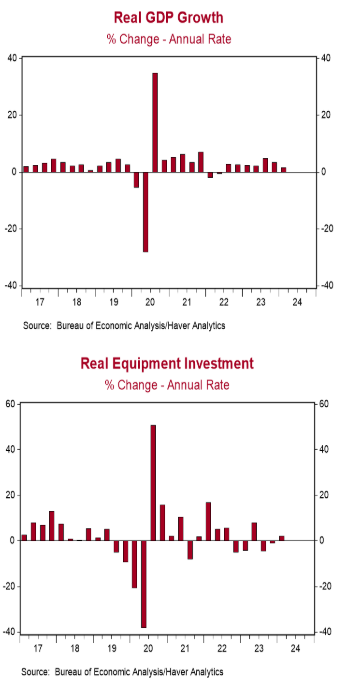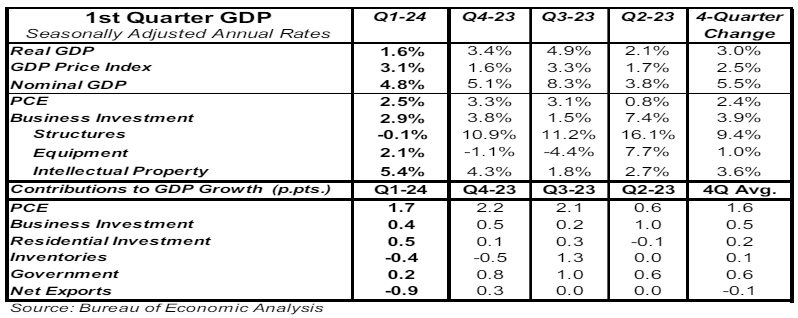- Real GDP increased at a 1.6% annual rate in Q1, well below the consensus expected 2.5%.
- The largest positive contribution to real GDP growth in Q1 came from personal consumption, while home building was also positive and the largest drag was net exports.
- Personal consumption, business fixed investment, and home building, combined, rose at a 3.1% annual rate in Q1. We refer to this as “core” GDP.
- The GDP price index increased at a 3.1% annual rate in Q1 and is up 2.5% from a year ago. Nominal GDP (real GDP plus inflation) rose at a 4.8% annual rate in Q1 and is up 5.5% from a year ago.
Implications: The Fed is not going to like today’s report on GDP. Yes, real GDP growth came in surprisingly slow in the first quarter, growing at a lukewarm 1.6% annual rate versus a consensus expected 2.5% pace. That 1.6% rate is the slowest growth rate in almost two years and lower than the forecast from any economics group on Bloomberg. However, we like to focus on “Core” GDP, which includes consumer spending, business fixed investment, and home building, while excluding government purchases, inventories, and international trade, the latter of which are very volatile from quarter to quarter. Core GDP increased at a healthy 3.1% rate in Q1, with consumer spending growing at a 2.5% annual rate, fixed business investment growing at a 2.9% rate, and home building up at a 13.9% rate. Meanwhile, inflation remained a big problem in the first quarter, with GDP prices up at a 3.1% annual rate, personal consumption prices up at a 3.4% pace, and core consumption prices up at a 3.7% rate. None of these figures are close enough to the Federal Reserve’s 2.0% target for monetary policymakers to start cutting rates. Nominal GDP – real GDP growth plus inflation – increased at a 4.8% rate in Q1 but is still up 5.5% from a year ago. Yet another figure indicating that a tighter monetary policy has yet to seriously bite. In turn, this means short-term interest rates will stay higher for longer and the risk of an eventual recession is not off the table. Some analysts and investors believe economic growth is continuing only because of a “supply side” boom based on AI and other innovations. But, if so, this supply-side boom would help push down inflation. Instead, we think the economy is still feeling the lingering effects of loose money, which is keeping both growth and inflation elevated. In other news this morning, new claims for unemployment insurance declined 5,000 last week to 207,000. Continuing claims dropped 15,000 to 1.781 million. Job growth continues in April.





